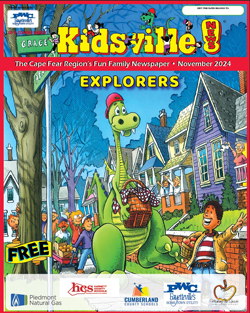
According to the National Christmas Tree Association, there are about 25-30 million real Christmas trees sold in the U.S. every year. Unlike their artificial counterparts, which may contain non-biodegradable plastics and possible metal toxins, real trees are a renewable, recyclable resource.
There are more than 4,000 local Christmas tree recycling programs throughout the U.S. and one of them is in Fayetteville.
The Grinding of the Greens is a local partnership between PWC, Duke Energy Progress, Fayetteville - Cumberland County Parks and Recreation and the Fayetteville Community Garden. Through the program, discarded trees are picked-up and turned into mulch used to beautify local parks.
City residents can place their discarded Christmas trees curb-side for pick-up by the morning of Jan. 4 to take advantage of the city-wide pick-up the first week of the new year. Anyone can take trees to the Fayetteville Community Garden, at the corner of Vanstory and Mann Streets, no later than Saturday, Jan. 9 by 8:30 a.m.
PWC spokesperson Carolyn Hinson said that without the recycling program, most of the trees would end up taking up space in the landfill.
“By recycling the trees and turning them into mulch, it’s a win-win for the environment. We save money for the city, save landfill space and a need is being met by Parks and Recreation by not having to buy mulch for parks,” Hinson said.
The program is not new.
“This is the 22nd year,” Hinson said. “The general premise was to find a way to recycle live Christmas trees so they are not going into the landfill. It encourages recycling and is a nice end to the holiday season, a gift to the environment.”
The program could not be successful without the 40 to 50 annual volunteers who come out on the morning of the grinding and operate the grinders, she said.
The event has become a tradition, she said, with many volunteers returning year after year. Mayor Nat Robertson will again be on-hand to give the official “Gentlemen, start your chippers!” call that begins the grinding.
“We don’t keep an exact count,” Hinson said, “But we have several thousand trees that are picked up each year.”
Residents who put their trees curb-side are encouraged to remove all lights and decorations, which can damage chippers.
“It’s always interesting to see what we’re going to find,” Hinson said. “Some trees have been fully decorated [and put on the curb], tree stands still attached.”
“We always have some people who come by the morning of grinding,” Hinson said. “We usually get 10-20 trees that morning.”
Christmas tree Facts
• The N.C. Christmas tree industry is ranked second in the nation in number of trees harvested and cash receipts.
• The top Christmas tree producing states are Oregon, North Carolina, Michigan, Pennsylvania, Wisconsin and Washington.
• N.C. produces more than 19 percent of the real Christmas trees in the U.S.
• The most common Christmas tree species are: balsam fir, Douglas-fir, Fraser fir, noble fir, Scotch pine, Virginia pine and white pine.
• N.C. has about 1,300 growers producing Fraser fir Christmas trees on an estimated 40,000 acres.
• Fraser fir represents more than 98 percent of all species grown in North Carolina.
• The N.C. Fraser fir has been judged the nation’s best in a contest sponsored by the National Christmas Tree Association and chosen for the official White House Christmas tree 12 times (more than any other species). The last N.C. tree in the White House was in 2012.
• The N.C. Fraser fir Christmas tree is the most popular Christmas tree in North America and is shipped into every state in the U.S. as well as the Caribbean Islands, Mexico, Canada, Bermuda, Japan and other points all over the world.
• For every real Christmas tree harvested, 1 to 3 seedlings are planted the following spring.
• It can take as many as 15 years to grow a tree of typical height (6 - 7 feet) or as little as 4 years, but the average growing time is 7 years.
Information provided by http://www.ncchristmastrees.com and http://www.realchristmastrees.org/dnn/Education/QuickTreeFacts.aspx

 How to resolve AdBlock issue?
How to resolve AdBlock issue? 








